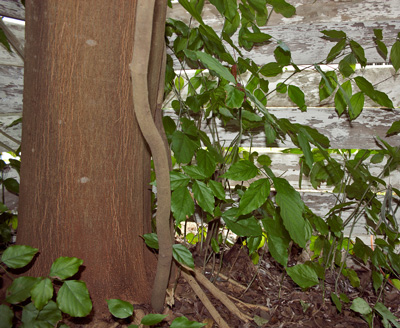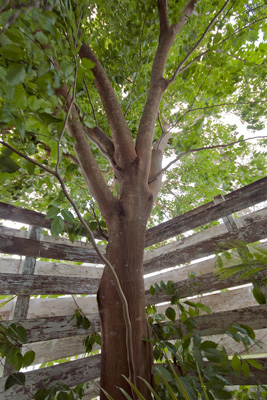Beware the invasive pongam tree

BY KENNETH SETZER
FAIRCHILD TROPICAL BOTANIC GARDEN
As published in the Miami Herald, 11/30/13.
Once upon a time, a seed sprouted in the corner of a suburban yard. The seedling grew and grew. Soon it overtook all of its neighboring plants and trees as they reached for the sun, competing for its life-giving light.
The man who cares for the yard noticed it when it grew into a sapling, and he wondered what species it could be. He wished the plants he tended would grow so vigorously. The man let the volunteer sapling continue, eager to discover its name.
Only a couple years later, the man noticed a huge tree that seemed to have appeared from out of nowhere, tucked into the same far corner of his yard. “Where did THAT come from,” he pondered. “Well, I’ve always wanted to build a treehouse.” That tree is now the tallest in his yard, out-competing his very tall bamboo and coconut palms.
The tree’s flowers are one of its distinguishing features, clustered into what look like groupings of small shells — like wind chimes you’d buy in the Keys — somewhat similar to the flowers of shell ginger. They are pale purple to a pearly, translucent white, almost like porcelain, and slightly fragrant.
Finding another tree with such flowers, I was able to identify my friend’s volunteer: it’s a pongam tree (Milletia pinnata, or Pongamia pinnata).
The tree originated in tropical and temperate areas of Asia, including India, Malesia, Japan, Thailand and parts of Australia and Oceania, and it seems almost inevitable that the pongam would make itself at home in South Florida.
Seeds were first introduced into the continental United States by David Fairchild in 1910; he grew a pongam at his home in Coconut Grove. It’s an interesting and beautiful ornamental shade tree, attaining heights of 30 to 50 feet or higher with a slightly drooping, weeping and very wide canopy. Its trunk is fairly short, and starts branching fairly low to the ground — the pongam I’m acquainted with branches about five feet up the trunk.

Seed pod from a pongam tree. Kenneth Setzer/FTBG.
A few months after the tree flowers, seed pods appear. Green and waxy, they mature to brown with a very tough skin. They must fall to the ground and decay to release the one or two seeds within.
The pongam’s high tolerance for salinity and occasional inundation, as well as its ability to stand up against in high winds, have led to its use along waterways. Indeed, it occurs naturally in such environments in Japan, China, Southeast Asia and India.
The pongam grew in popularity with developers in the late 1980s, mainly because it is fast growing. Initially chosen for planting along the new Metrorail, it was rejected in favor of less-messy plantings; this in turn created a glut of pongams previously slated for public planting. The resulting reduced prices were undoubtedly appealing to developers and landscapers.
Here’s why the pongam is too good to be true: It crowds out our natives and is highly invasive. It reproduces not only by producing hundreds of seed pods, but by sending up root suckers quicker than a mushroom grows after a rainstorm. In addition to the root suckers, dozens of seedlings spread out from its base. The surface roots also travel, sending up more suckers in surprising places far from the parent tree.

Suckers and seedlings of the pongam tree can get out of control. Kenneth Setzer/FTBG.
The tree is also a bit messy. It is temporarily deciduous, defoliating for about a month in spring. Then it flowers and flowers — and drops the flowers by the thousands everywhere. Most parts of this tree are in some way toxic; the flowers are known to stun or kill fish. You could compost the leaves and flowers, which are quite oily.
I can understand why David Fairchild investigated the pongam: He searched the world for plants that offer something of practical use, such as food, animal fodder, insect and disease resistance, or erosion control.
The pongam’s many uses are legend — in its native range. One of the products derived from its seeds is oil, which is inedible but is being considered for use as a biofuel. Its wood, bark and other derivatives serve multiple uses also, from the prosaic to the ethnobotanical.

Pongam tree tends to have a wide spread. Kenneth Setzer/FTBG.
Miami-Dade County lists it as a “Controlled Landscape plant,” meaning it may not be planted within 500 feet of native plant communities. Pinelands are listed as especially susceptible to pongam invasion. So if you identify a pongam growing on your property, keep in mind the mess, the suckers, and the running roots. You might remove it — and ideally, replace it with a native.
